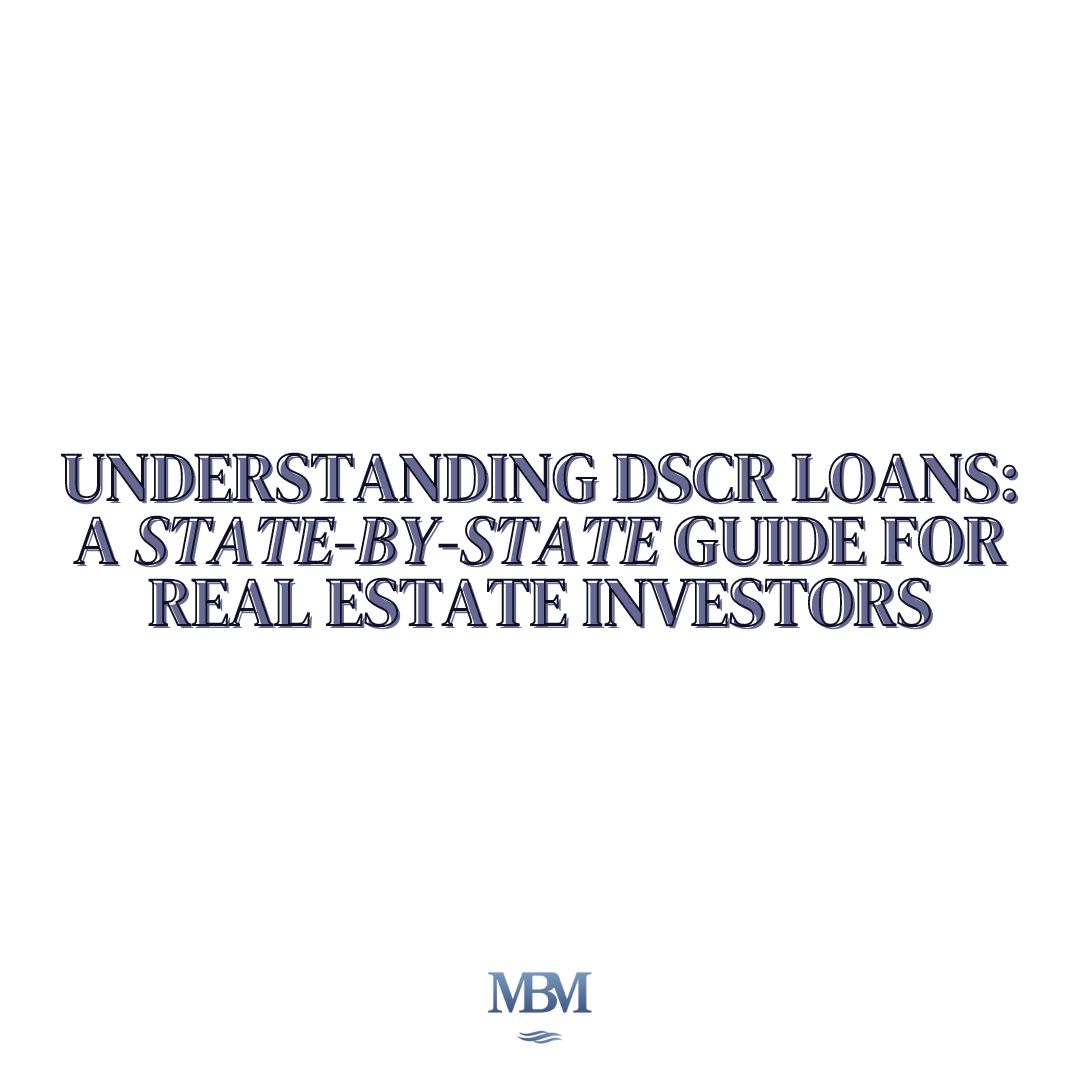Financing plays a crucial role in determining the success and scalability of your ventures. Among the various financing options available, DSCR loans have gained significant popularity, especially among investors looking to expand their portfolios efficiently. This comprehensive guide will delve into the intricacies of DSCR loans, their benefits, and how they vary across different states.
What is a DSCR Loan?
DSCR stands for Debt Service Coverage Ratio. A DSCR loan is a type of mortgage that bases its approval primarily on the cash flow of the property being financed, rather than the borrower’s personal income. The Debt Service Coverage Ratio is a measure of the property’s ability to cover its debt obligations.
The DSCR Formula:
DSCR = Net Operating Income (NOI) / Total Debt Service
- A DSCR of 1.0 means the property’s income exactly covers its debt obligations.
- A DSCR above 1.0 indicates positive cash flow.
- A DSCR below 1.0 suggests negative cash flow.
Most lenders require a minimum DSCR of 1.25, meaning the property’s income should be at least 25% higher than its debt obligations.
Benefits of DSCR Loans for Real Estate Investors
- No Income Verification: DSCR loans don’t require personal income verification, making them ideal for self-employed investors or those with complex income structures.
- Faster Approval Process: With fewer documents to review, DSCR loans often have a quicker approval process compared to conventional mortgages.
- Scalability: Investors can potentially qualify for multiple properties more easily, as each property is evaluated independently based on its own cash flow.
- Flexibility: DSCR loans can be used for various property types, including single-family rentals, multi-family units, and sometimes commercial properties.
- Competitive Rates: While rates are typically higher than conventional mortgages, they can be competitive for investment property loans.
DSCR Loan Requirements
While requirements can vary by lender and state, common DSCR loan requirements include:
- Minimum DSCR (typically 1.25 or higher)
- Minimum credit score (often 640+)
- Down payment (usually 20-25%)
- Cash reserves (often 6-12 months of mortgage payments)
- Property must be for investment purposes, not owner-occupied
State-by-State Guide to DSCR Loans
DSCR loan terms and availability can vary significantly from state to state due to different real estate markets, regulations, and economic conditions. Let’s explore DSCR loans in several key states:
DSCR Loan Florida
Florida’s robust real estate market and strong rental demand make it an attractive state for DSCR loans.
Key Points:
- Minimum DSCR: Often 1.25
- Popular Areas: Miami, Orlando, Tampa
- Property Types: Single-family homes, condos, multi-family units
- Market Trend: High demand for short-term rentals in tourist areas
Florida-Specific Consideration: Hurricane insurance may be required, potentially affecting the DSCR calculation.
DSCR Loan California
California’s diverse and often expensive real estate market presents unique opportunities and challenges for DSCR loans.
Key Points:
- Minimum DSCR: Can be as high as 1.30-1.35 in some areas
- Popular Areas: Los Angeles, San Francisco, San Diego
- Property Types: Single-family homes, multi-family units, sometimes commercial
- Market Trend: High property values may require larger loan amounts
California-Specific Consideration: Strict rent control laws in some cities may impact DSCR calculations and loan approval.
DSCR Loan Texas
Texas’s growing population and business-friendly environment make it an attractive market for real estate investors.
Key Points:
- Minimum DSCR: Often 1.25
- Popular Areas: Austin, Dallas, Houston
- Property Types: Single-family homes, multi-family units
- Market Trend: Strong job growth driving rental demand
Texas-Specific Consideration: Property tax rates are relatively high, which can significantly impact DSCR calculations.
DSCR Loan New York
New York’s diverse real estate market, from bustling urban centers to quieter suburban areas, offers various opportunities for DSCR loans.
Key Points:
- Minimum DSCR: Can be as high as 1.35-1.40 in NYC
- Popular Areas: New York City, Long Island, Albany
- Property Types: Multi-family units, mixed-use buildings
- Market Trend: High demand for rentals in urban areas
New York-Specific Consideration: Strict building codes and regulations can impact renovation costs and timelines for investment properties.
DSCR Loan Illinois
Illinois, particularly the Chicago area, offers a mix of urban and suburban investment opportunities suitable for DSCR loans.
Key Points:
- Minimum DSCR: Typically 1.25
- Popular Areas: Chicago, Naperville, Aurora
- Property Types: Multi-family units, single-family homes
- Market Trend: Growing demand for suburban rentals
Illinois-Specific Consideration: Property taxes can be high, especially in Cook County, affecting DSCR calculations.
DSCR Loan Georgia
Georgia’s growing economy and affordable real estate market make it attractive for DSCR loan investors.
Key Points:
- Minimum DSCR: Often 1.25
- Popular Areas: Atlanta, Savannah, Augusta
- Property Types: Single-family homes, multi-family units
- Market Trend: Strong job market driving rental demand
Georgia-Specific Consideration: Relatively landlord-friendly laws can make property management easier for investors.
DSCR Loan Arizona
Arizona’s warm climate and growing population make it a popular destination for both long-term rentals and vacation properties.
Key Points:
- Minimum DSCR: Typically 1.25
- Popular Areas: Phoenix, Tucson, Scottsdale
- Property Types: Single-family homes, condos
- Market Trend: Strong demand for retirement communities and vacation rentals
Arizona-Specific Consideration: Seasonal rental market in some areas may affect year-round DSCR calculations.
DSCR Loan Washington
Washington state’s strong tech industry and natural beauty drive its real estate market, offering diverse opportunities for DSCR loans.
Key Points:
- Minimum DSCR: Can be 1.25-1.30
- Popular Areas: Seattle, Bellevue, Spokane
- Property Types: Single-family homes, multi-family units
- Market Trend: High rental demand in tech-centric areas
Washington-Specific Consideration: Some areas have implemented strict short-term rental regulations, which may impact investment strategies.
DSCR Loan Colorado
Colorado’s outdoor lifestyle and growing tech scene make it an attractive market for real estate investors.
Key Points:
- Minimum DSCR: Often 1.25
- Popular Areas: Denver, Boulder, Colorado Springs
- Property Types: Single-family homes, multi-family units
- Market Trend: Strong demand for rentals in urban and ski resort areas
Colorado-Specific Consideration: High altitude can increase maintenance costs, potentially affecting long-term DSCR calculations.
DSCR Loan Massachusetts
Massachusetts offers a mix of urban, suburban, and coastal properties suitable for DSCR loan investments.
Key Points:
- Minimum DSCR: Can be as high as 1.30-1.35 in Boston area
- Popular Areas: Boston, Cambridge, Worcester
- Property Types: Multi-family units, single-family homes
- Market Trend: Strong demand for student housing near universities
Massachusetts-Specific Consideration: Strict winter weather regulations can increase property maintenance costs.
How to Apply for a DSCR Loan
- Gather Necessary Documents:
- Property details
- Rent roll or lease agreements
- Property operating statements
- Personal credit report
- Proof of down payment and reserves
- Calculate Your DSCR: Use the formula mentioned earlier to estimate your property’s DSCR.
- Shop Around: Different lenders may offer varying terms and rates. Compare offers from multiple lenders.
- Submit Your Application: Provide all required documents and information to your chosen lender.
- Property Appraisal: The lender will typically order an appraisal to verify the property’s value.
- Underwriting: The lender reviews your application and property details.
- Closing: If approved, you’ll sign final documents and receive your loan.
DSCR Loan Tips and Best Practices
- Improve Your DSCR: Look for ways to increase property income or reduce expenses to boost your DSCR.
- Maintain Good Credit: While DSCR loans focus on property cash flow, a good credit score can help you secure better terms.
- Build Cash Reserves: Having substantial cash reserves can make you a more attractive borrower and help you weather unexpected expenses.
- Understand Local Markets: Each state and even city can have unique factors affecting real estate investments. Do thorough market research.
- Plan for Vacancies: Don’t assume 100% occupancy. Factor in potential vacancies when calculating your DSCR.
- Consider Long-Term Sustainability: While short-term rentals might boost income, consider the long-term stability of your investment.
- Seek Professional Advice: Consult with real estate attorneys, accountants, and experienced investors familiar with your target market.
Potential Drawbacks of DSCR Loans
While DSCR loans offer many benefits, they’re not without potential drawbacks:
- Higher Interest Rates: Rates are typically higher than conventional mortgages.
- Larger Down Payments: Many DSCR loans require at least 20-25% down.
- Prepayment Penalties: Some DSCR loans may have prepayment penalties.
- Property Restrictions: Certain property types may not qualify for DSCR loans.
- Market Sensitivity: Economic downturns affecting rental income could impact your ability to maintain a satisfactory DSCR.
The Future of DSCR Loans
As the real estate investment landscape evolves, DSCR loans are likely to remain a popular option for investors. Some potential trends to watch:
- Technology Integration: Improved data analytics may streamline the DSCR calculation and approval process.
- Expansion to New Markets: DSCR loans may become more widely available in emerging real estate markets.
- Adaptation to Market Changes: Lenders may adjust DSCR requirements in response to economic shifts.
- Green Building Incentives: Some lenders might offer preferential terms for energy-efficient or sustainable properties.
- Increased Regulation: As DSCR loans grow in popularity, they may face additional regulatory scrutiny.
Conclusion
DSCR loans offer a powerful financing tool for real estate investors looking to expand their portfolios efficiently. By focusing on property cash flow rather than personal income, these loans can open up new opportunities for investors across various states.
However, it’s crucial to understand that DSCR loan terms, requirements, and market conditions can vary significantly from state to state. What works in Florida might not be ideal in California or New York. As a savvy investor, it’s essential to thoroughly research your target market, understand local regulations, and carefully consider how a DSCR loan fits into your overall investment strategy.
Remember, while DSCR loans can offer more flexibility and scalability than traditional mortgages, they also come with their own set of risks and considerations. Always do your due diligence, consult with professionals familiar with your target market, and carefully weigh the pros and cons before proceeding with any investment.
Are you considering using a DSCR loan for your next real estate investment? Which state’s market are you most interested in exploring? Share your thoughts and experiences in the comments below!




